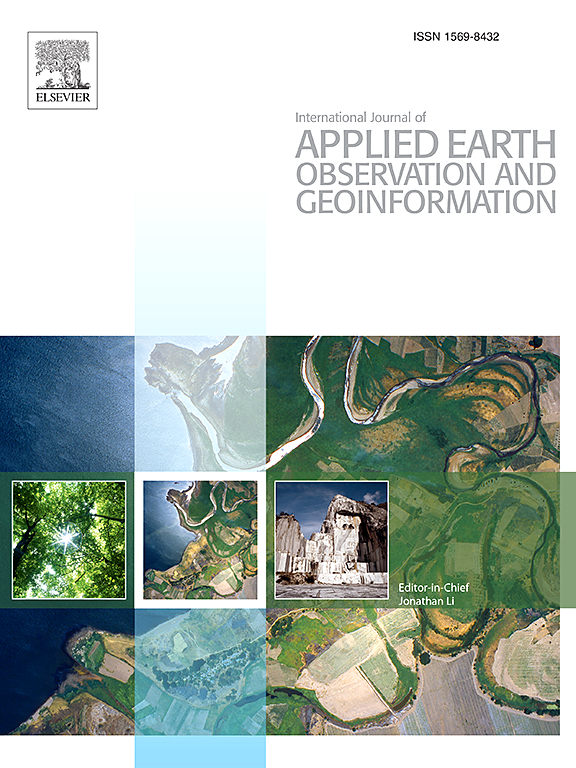Employing sentinel-2 time-series and noisy data quality control enhance crop classification in arid environments: A comparison of machine learning and deep learning methods
IF 8.6
Q1 REMOTE SENSING
International journal of applied earth observation and geoinformation : ITC journal
Pub Date : 2025-06-25
DOI:10.1016/j.jag.2025.104678
引用次数: 0
Abstract
Accurate and timely mapping of agricultural products is a crucial component in management and decision-making for promoting food security and sustainable development. The intricacy of differentiating diverse croplands due to the existence of small and winding agricultural fragments contributes to the complexity of crop classification in arid environments. In this study, we employed a novel hybrid approach, integrating time-series analysis, noisy data quality control, and different machine learning and deep learning models to classify croplands of complex multi-crop systems in central Iran. The classification was based on time series spectral bands of Sentinel-2 images and indices of crop growth phenology, providing valuable insights into the growth cycles of different crops in the region. Additionally, a neural network-based method was used to assess and enhance the quality of training data before modeling. For crop classification, we used four machine learning and deep learning methods including Extreme Gradient Boosting (XGBoost), Random Forest (RF), Support Vector Machine (SVM), and Temporal Convolutional Neural Network (TCNN), and compared their results before and after quality control measures. The results indicated that after quality control, the overall accuracy and Kappa coefficient of the analyses were considerably improved. RF and TCNN methods demonstrated superior prediction and modeling performance compared to XGBoost and SVM models. The overall accuracy of the four methods increased from 91 %, 87 %, 83 %, and 91 % before quality control to 96 %, 94 %, 89 %, and 95 % after quality control, respectively. The results of this study highlight the effectiveness of employing time-series data and quality control procedures to enhance crop classification in complex agricultural systems. By improving the precision and accuracy of agricultural classifications our findings can contribute to optimizing resource management, food security, and sustainable development goals.
利用sentinel-2时间序列和噪声数据质量控制增强干旱环境下作物分类:机器学习和深度学习方法的比较
准确、及时地绘制农产品地图是促进粮食安全和可持续发展的管理和决策的关键组成部分。由于小而蜿蜒的农业碎片的存在,区分不同农田的复杂性增加了干旱环境下作物分类的复杂性。在这项研究中,我们采用了一种新的混合方法,将时间序列分析、噪声数据质量控制以及不同的机器学习和深度学习模型结合起来,对伊朗中部复杂的多作物系统的农田进行分类。该分类基于Sentinel-2遥感影像的时间序列光谱波段和作物生长物候指数,为了解该地区不同作物的生长周期提供了有价值的信息。此外,在建模之前,使用基于神经网络的方法来评估和提高训练数据的质量。在作物分类中,我们使用了极端梯度增强(XGBoost)、随机森林(RF)、支持向量机(SVM)和颞卷积神经网络(TCNN)四种机器学习和深度学习方法,并比较了它们在质量控制措施前后的结果。结果表明,经质量控制后,分析的总体准确度和Kappa系数均有较大提高。与XGBoost和SVM模型相比,RF和TCNN方法具有更好的预测和建模性能。四种方法的总体准确度分别从质量控制前的91%、87%、83%和91%提高到质量控制后的96%、94%、89%和95%。本研究结果强调了采用时间序列数据和质量控制程序来增强复杂农业系统中作物分类的有效性。通过提高农业分类的精度和准确性,我们的研究结果可以为优化资源管理、粮食安全和可持续发展目标做出贡献。
本文章由计算机程序翻译,如有差异,请以英文原文为准。
求助全文
约1分钟内获得全文
求助全文
来源期刊

International journal of applied earth observation and geoinformation : ITC journal
Global and Planetary Change, Management, Monitoring, Policy and Law, Earth-Surface Processes, Computers in Earth Sciences
CiteScore
12.00
自引率
0.00%
发文量
0
审稿时长
77 days
期刊介绍:
The International Journal of Applied Earth Observation and Geoinformation publishes original papers that utilize earth observation data for natural resource and environmental inventory and management. These data primarily originate from remote sensing platforms, including satellites and aircraft, supplemented by surface and subsurface measurements. Addressing natural resources such as forests, agricultural land, soils, and water, as well as environmental concerns like biodiversity, land degradation, and hazards, the journal explores conceptual and data-driven approaches. It covers geoinformation themes like capturing, databasing, visualization, interpretation, data quality, and spatial uncertainty.
 求助内容:
求助内容: 应助结果提醒方式:
应助结果提醒方式:


